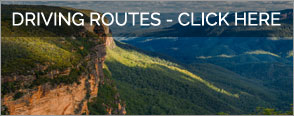The Greater Blue Mountains World Heritage Area only exists today because of a 70-year campaign by conservationists to achieve a chain of reserves across the region.
This culminated in the year 2000 with the acceptance of 10,000 square kilometres of wild bushland onto the World Heritage list - the 'best of the best'.
The eight connected conservation areas of Wollemi, Yengo, Gardens of Stone, Blue Mountains, Kanangra-Boyd, Nattai and Thirlmere Lakes national parks and Jenolan Karst Conservation Reserve make up Australia's most accessible World Heritage Area. It extends 220 km from the Southern Highlands to the Hunter Valley, and from western Sydney to the farming tablelands of the Great Divide.
Six Aboriginal language groups treasure connections with the Country of the Greater Blue Mountains that reach back into ancient time. They are the Dharawal and Gundungurra people (in the south), the Wiradjuri (in the west and north-west), and the Wanaruah, Darkinjung, and Darug (in the north-east).
Remember as you journey around the area that many of today's roads retrace traditional Aboriginal pathways that the early European settlers followed out of the Sydney basin.
The World Heritage Area is divided into four geographical sectors reflecting changes in landscape and vegetation. Each is named after a local landmark with an Aboriginal name: Monundilla (north-west), Mellong (north-east), Kedumba (central) and Colong (south).





